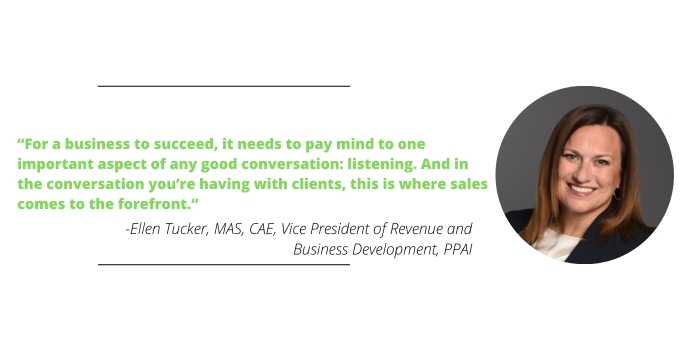Listening On A Deeper Level

By now we've all heard many brands refer to their marketing efforts as a “conversation” with customers. But I think that cliché misses the mark by quite a bit.
Yes, you could think of marketing as the things you’re saying to clients. So much of marketing is about expressing the combination of ideas, values and opportunities you bring to the table. But that by itself is not a conversation with a person. That’s talking at someone.
For a business to succeed, it needs to pay mind to the other important aspect of any good conversation: listening. And in the conversation you’re having with clients, this is where sales comes to the forefront.
What is selling if not taking account of what a customer needs, considering their unique situation and understanding them on a deeper level so that you can best support them?
It’s a fine metaphor, but promo pros would be smart to consider the point more literally. The brilliant thing is, intentional listening sets you up to deliver exactly what a client wants when it’s your turn to speak about all the great solutions you have in mind for them.
We all know the basics of listening with intention. Put your phone away, look them in the eyes, ask important questions and so forth. But what I’m talking about goes deeper. If you’re really listening and paying attention to a client, you can begin to read who they are and how they want you to approach the situation.
Just like a friend sharing their relationship struggles or a co-worker venting their work frustrations, your client wants to be understood. When you make an effort to read them and understand how they best interact, you set yourself up to be a rewarding conversation partner.
I can look back on times early in my career, working in true sales roles, when I wish I’d known to make a more intentional effort to read people, particularly their preferred communication styles, and in turn adjust my selling approach to suit them. Some people are asking sellers to convince them with a long narrative arc about the why behind a product. Others want three bullet points so they can assess and move onto their next purchasing decision.
It’s only when you make the intentional effort to read the client that you can get a sense of what they will respond to. I was always happy to provide the bullet points, but perhaps I could’ve done a better job offering a storyteller’s approach with different clients through the years.
It was only when I got into management that I truly understood this aspect of communication. From Day 1 when leading people, we intuitively know that different employees require different management styles. Some people are asking for general direction: Wind them up and let them go. Some want to talk through all the angles, measuring twice and cutting once. Different employees may respond to different motivations.
 It’s only from spending more time with your people and observing them that you can begin to know what they want from you as a leader. Luckily, a relationship with an employee isn’t like cold calling. You have time to let it develop and learn from each interaction.
It’s only from spending more time with your people and observing them that you can begin to know what they want from you as a leader. Luckily, a relationship with an employee isn’t like cold calling. You have time to let it develop and learn from each interaction.
This is possible in sales, too. It’s the difference between relational selling and transactional selling. When salespeople revert back to their own personal communication preferences, they’re being transactional. When they adapt themselves to the individual client, a relationship can begin to be formed, and each interaction enhances the trust and interactivity between client and vendor.
Ultimately, that’s the idea behind the common salesperson title “account manager.” We want sellers to think of their accounts like leaders do of their individual employees, tailoring the style to fit the individual.
If your salespeople aren’t able to make that brain switch, they will always be chasing. They may put in a lot of effort without much to show for it.
So, is your business good at conversation? No company succeeds for very long in any industry – let alone one so competitive as promo – without excelling at both marketing and sales. Make sure you’re intentional about reading your clients and their preferences and you’ll improve at both.
Tucker is vice president of revenue and business development at PPAI.

